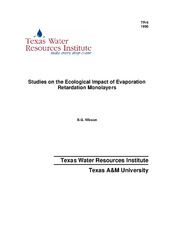| dc.description.abstract | Clean fresh water is the most precious natural resource available to mankind. People must have water for personal, municipal, industrial and recreational use. At the present time, most of the available fresh water in the United States is used in some way or another, treated and returned to streams, rivers, lakes and reservoirs for reuse. Terrain, geographic location, climate and economics dictate that most of our usable fresh water be retained in lakes and reservoirs. This type of water storage allows for the greatest loss of water by evaporation.
The increasing demand for municipal, industrial and recreational fresh water has set in motion a vast impoundment program in the United States that will accelerate water evaporation control measures in the immediate future. According to Smerdon,l water loss by evaporation in the United States actually exceeds by over 1O times the total amount of water needed for municipal and Industrial usage. In the United States alone, five billion acre-feet of water falls as precipitation each year. Of this amount over 3.5 billion gallons of water is returned to the atmosphere by evaporation or transpiration.
Americans are now consuming 355 billion gallons of water per day and this amount is expected to increase to 6OO billion gallons per day by 198O. Home use of water represents less than 1O% of the national consumption. Nearly half of the water is used for irrigation and the remaining 4O% is used by industry. Water conservation is a necessity in arid states that have scant rainfall and high evaporation losses. Eaton 3 reported that approximately 11.5 million acre-feet of water is lost due to evaporation each year in our eleven western states.
Scientists and engineers have considered many physical and chemical methods in an attempt to reduce water evaporation losses from lakes and reservoirs. One OT the new and most promising techniques is the application of a thin chemical film on the surface of the water to retard evaporation.
An array of evaporation reduction chemicals has been utilized on reservoirs and lakes in different manners by Mansfield,4 Cruse and Harbeck,5 Timblin, Florey and Garstha,6 and Meinke and Waldrip 7 to suppress evaporation and conserve water. One of the most promising of the current evaporation retardant chemicals is a blend of hexadecanol and octadecanol (Durham and McArthur).8 These longchain fatty alcohols form a monomolecular film on the water surface that is self-healing at wind speeds of up to eight miles per hour (Gilby and Heymann) 9 and is capable of reducing water evaporation by 30 to 50% under ideal conditions. According to Ludzack and Ettinger,10 and Chang, et al. 1l the monolayer is biodegradable and can be assimilated by bacteria in the water as food.
According to Wiltzius, 12 hexadecanol and octadecanol are nontoxic and do not present a health hazard in potable water. However, research indicates that monolayers change some of the physical and chemical characteristics in the treated aquatic environments. A monolayer will calm the water surface and form a slight diffusion barrier to the transfer of gases into and out of the water environment. The film will also decrease the surface tension of the water surface by 50% or more from a normal 60 to 72 dynes per centimeter to less than 4O dynes per centimeter. Furthermore, the film causes a slight temperature increase in the water immediately below the film. All of these factors may significantly affect the ecology of ponds, lakes and reservoirs.
While field studies have shown hexadecanol and octadecanol films to be successful in suppressing water evaporation, the ecological studies of such treated water have not been adequate. A comparative evaluation of the biologic effects due to complete coverage of water by an evaporation retardant monolayer has not been possible under field conditions. The day-to-day environmental conditions of rapid temperature changes, wind, dust, rain, light fluctuations and other unpredictable factors do not allow a realistic evaluation of the ecological changes that may be caused by a continuous water-saving film.
The small laboratory ecosystem has long been a fundamental tool in the development of comparative ecology. These systems have also been called microcosms by Odum and Hoskins 13 and laboratory microecosystems by Beyers. These small ecosystems may be used to study changes in water quality and population characteristics under controlled conditions obtained only in the laboratory. With the microcosm, one does not experience the complexity, environmental variation, difficulty of replication, and handicap of sheer size presented by natural ecosystems. However, unnatural environmental conditions must be recognized when small laboratory ecosystems are used. Laboratory studies in experimental microcosms can not duplicate the complex ecosystem present in lakes and reservoirs.
An intensive literature survey has revealed no prior attempt to evaluate the ecological impact of a continuously applied evaporation reduction film on a laboratory experimental microcosm.
The objectives of this research have been to evaluate, under laboratory controlled conditions, the ecological changes caused by the continuous application of a hexadecanol and octadecanol evaporation-suppression film on experimental ecosystems. The effects of a monolayer on algal populations will provide information not currently available. | en |


